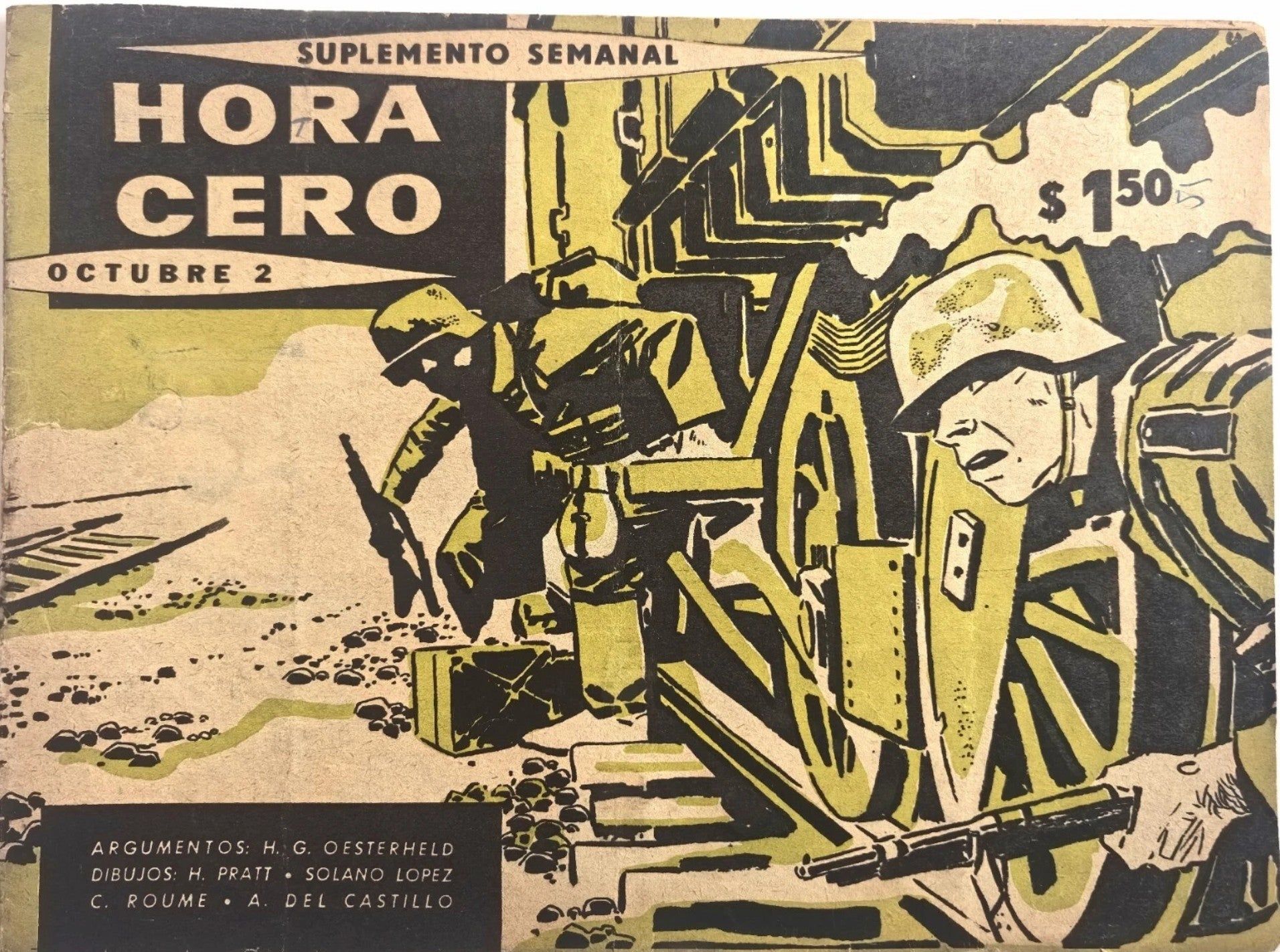Argentinean Anti-Authoritarian Sci-Fi Comic El Eternauta in Hora Cero Suplemento Semanal, 1957
- SIGNED
Oesterheld, Héctor Germán. Hora Cero Suplemento Semanal No. 5. Buenos Aires: Editorial Frontera, October 2, 1957. First printing. Oblong 8vo. Original printed wrappers. Text in Spanish. A landmark early issue of Hora Cero Suplemento Semanal, the short-lived but revolutionary Argentine comics weekly founded in 1957 by Héctor Germán Oesterheld, one of Latin America’s most influential graphic storytellers. Oesterheld’s later rewriting of the story in the 1970s, at the height of Argentina’s military dictatorship, was widely interpreted as an allegory of authoritarian repression. Oesterheld himself was disappeared by the junta in 1977, cementing El Eternauta as a text of both artistic and political martyrdom.
Issue No. 5 contains the first serialized works that would define the “Oesterheld school” of socially engaged comics, including “El Eternauta”, the mythic science-fiction allegory of invasion and resistance. drawn by Francisco Solano López; “Ernie Pike,” Oesterheld’s humanistic anti-war chronicle with Hugo Pratt; and “Randall the Killer,” a western collaboration with Arturo del Castillo. The series first appeared in Hora Cero Semanal (1957–59) and has since been recognized as the foundational classic of Argentine comics. Set in Buenos Aires during an alien invasion disguised as a deadly snowfall, the narrative follows ordinary citizens struggling to survive, emphasizing solidarity, resistance, and the collective over the lone hero. Oesterheld’s later rewriting of the story in the 1970s, at the height of Argentina’s military dictatorship, was widely interpreted as an allegory of authoritarian repression. Oesterheld himself was disappeared by the junta in 1977, cementing El Eternauta as a text of both artistic and political martyrdom. Conceived amid Argentina’s post-Perón ferment, Hora Cero reinvented the adventure comic as a vehicle for moral inquiry, political critique, and existential reflection, merging pulp action with the narrative complexity that would later influence Metal Hurlant and Latin American graphic realism The striking cover depicts German soldiers disembarking from an armored train, rendered in bold chiaroscuro linework by Pratt and Solano López, emblematic of the magazine’s cinematic style and its obsession with the psychology of war. Light handling wear and minor toning to covers; interior remarkably clean and supple. Overall very good condition. A scarce surviving issue from the first year of publication of the most important Argentine comics magazine of the twentieth century, birthplace of El Eternauta and the modern Latin American graphic novel.
Issue No. 5 contains the first serialized works that would define the “Oesterheld school” of socially engaged comics, including “El Eternauta”, the mythic science-fiction allegory of invasion and resistance. drawn by Francisco Solano López; “Ernie Pike,” Oesterheld’s humanistic anti-war chronicle with Hugo Pratt; and “Randall the Killer,” a western collaboration with Arturo del Castillo. The series first appeared in Hora Cero Semanal (1957–59) and has since been recognized as the foundational classic of Argentine comics. Set in Buenos Aires during an alien invasion disguised as a deadly snowfall, the narrative follows ordinary citizens struggling to survive, emphasizing solidarity, resistance, and the collective over the lone hero. Oesterheld’s later rewriting of the story in the 1970s, at the height of Argentina’s military dictatorship, was widely interpreted as an allegory of authoritarian repression. Oesterheld himself was disappeared by the junta in 1977, cementing El Eternauta as a text of both artistic and political martyrdom. Conceived amid Argentina’s post-Perón ferment, Hora Cero reinvented the adventure comic as a vehicle for moral inquiry, political critique, and existential reflection, merging pulp action with the narrative complexity that would later influence Metal Hurlant and Latin American graphic realism The striking cover depicts German soldiers disembarking from an armored train, rendered in bold chiaroscuro linework by Pratt and Solano López, emblematic of the magazine’s cinematic style and its obsession with the psychology of war. Light handling wear and minor toning to covers; interior remarkably clean and supple. Overall very good condition. A scarce surviving issue from the first year of publication of the most important Argentine comics magazine of the twentieth century, birthplace of El Eternauta and the modern Latin American graphic novel.


